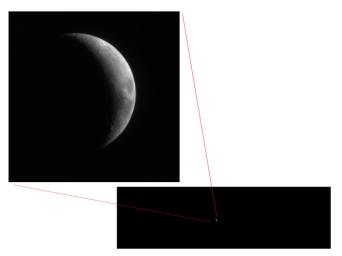Full-Frame Reference for Test Photo of Moon
Caption:
This pair of views shows how little of the full image frame was taken up by the Moon in test images taken Sept. 8, 2005, by the High Resolution Imaging Science Experiment (HiRISE) camera on NASA's Mars Reconnaissance Orbiter. The Mars-bound camera imaged Earth's Moon from a distance of about 10 million kilometers (6 million miles) away -- 26 times the distance between Earth and the Moon -- as part of an activity to test and calibrate the camera. The images are very significant because they show that the Mars Reconnaissance Orbiter spacecraft and this camera can properly operate together to collect very high-resolution images of Mars. The target must move through the camera's telescope view in just the right direction and speed to acquire a proper image. The day's test images also demonstrate that the focus mechanism works properly with the telescope to produce sharp images.
Out of the 20,000-pixel-by-6,000-pixel full frame, the Moon's diameter is about 340 pixels, if the full Moon could be seen. The illuminated crescent is about 60 pixels wide, and the resolution is about 10 kilometers (6 miles) per pixel. At Mars, the entire image region will be filled with high-resolution information.
Background Info:
The Mars Reconnaissance Orbiter, launched on Aug. 12, 2005, is on course to reach Mars on March 10, 2006. After gradually adjusting the shape of its orbit for half a year, it will begin its primary science phase in November 2006. From the mission's planned science orbit about 300 kilometers (186 miles) above the surface of Mars, the high resolution camera will be able to discern features as small as one meter or yard across.
The Mars Reconnaissance Orbiter mission is managed by NASA's Jet Propulsion Laboratory, a division of the California Institute of Technology, Pasadena, for the NASA Science Mission Directorate. Lockheed Martin Space Systems, Denver, prime contractor for the project, built the spacecraft. Ball Aerospace & Technologies Corp., Boulder, Colo., built the High Resolution Imaging Science Experiment instrument for the University of Arizona, Tucson, to provide to the mission. The HiRISE Operations Center at the University of Arizona processes images from the camera.
Cataloging Keywords:
| Name |
Value |
Additional Values |
| Target |
Moon |
Mars |
| System |
Earth |
|
| Target Type |
Satellite |
Planet |
| Mission |
Mars Reconnaissance Orbiter (MRO) |
|
| Instrument Host |
Mars Reconnaissance Orbiter |
|
| Host Type |
Orbiter |
|
| Instrument |
High Resolution Imaging Science Experiment (HiRISE) |
|
| Detector |
|
|
| Extra Keywords |
Color |
| Acquisition Date |
|
| Release Date |
2005-09-10 |
| Date in Caption |
|
|
| Image Credit |
NASA/JPL/University of Arizona |
| Source |
photojournal.jpl.nasa.gov/catalog/PIA08005 |
| Identifier |
PIA08005 |

 Planetary Data System
Planetary Data System
